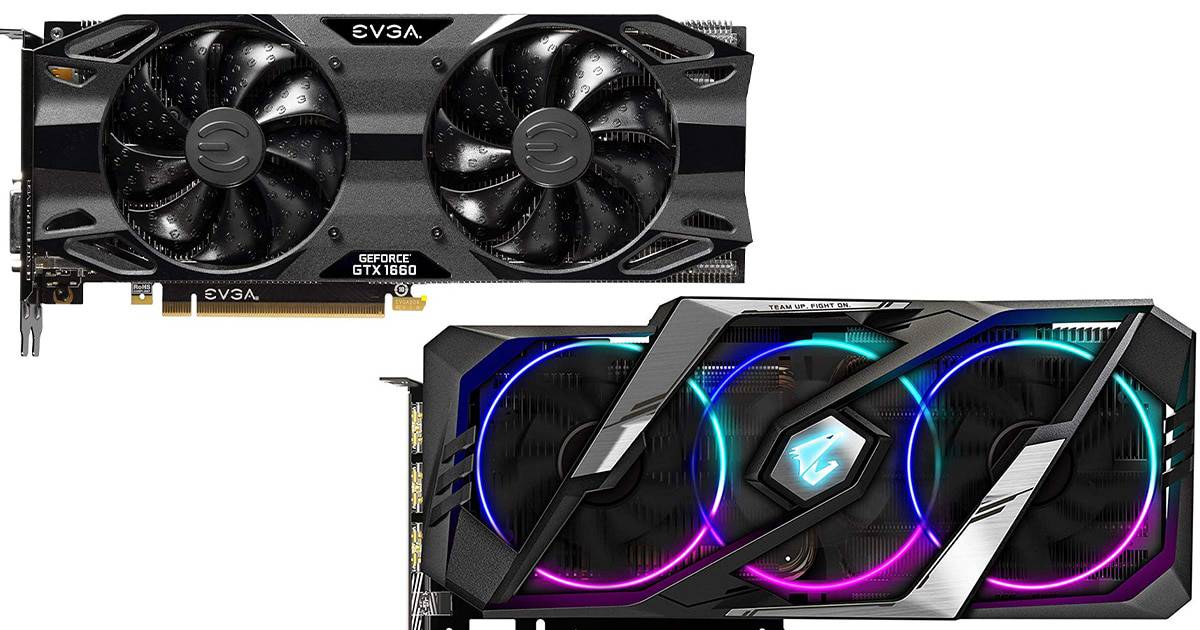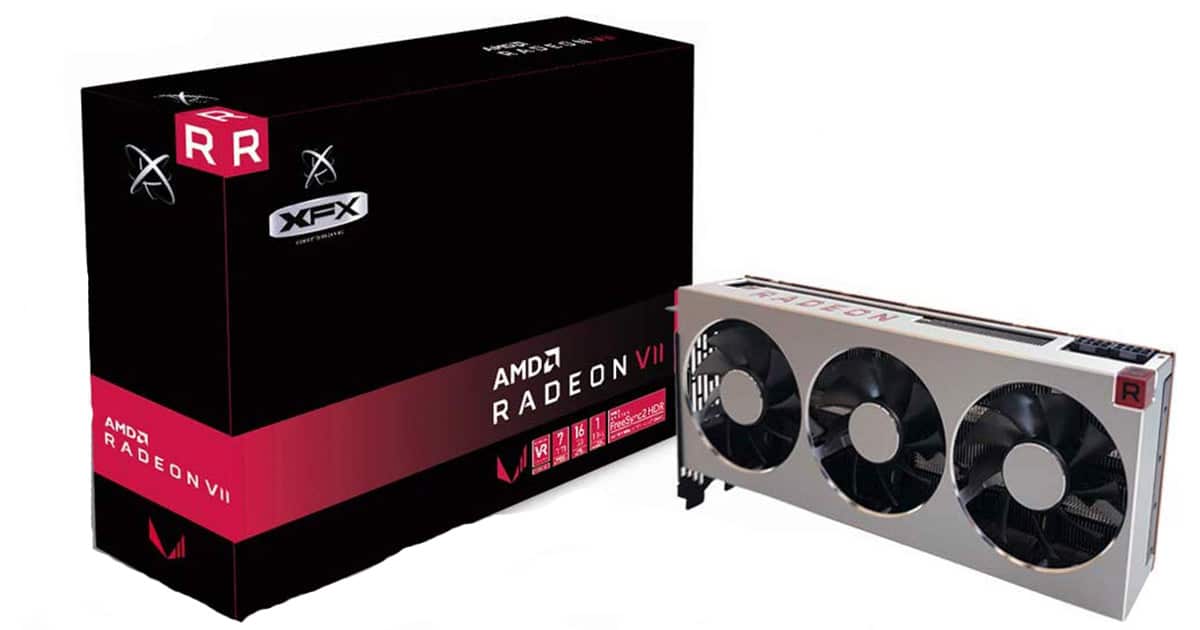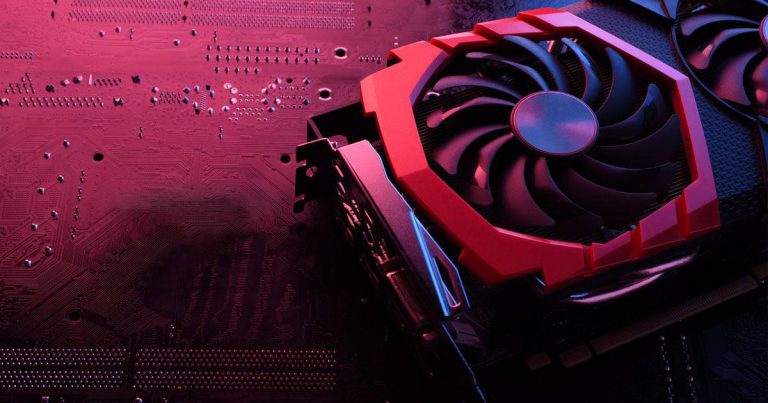Once you start getting into the gaming space, PC or otherwise, chances are you’ll hear a lot about GPUs and the latest graphics card. In this article, we’re going to give a PC-centric explanation of graphics card technology and how it’s relevant to you as a consumer- if you aren’t an expert, don’t worry. We’ll explain everything you need to know below.
What is a GPU (graphics card)?
First and foremost, let’s define what a GPU is. GPU stands for Graphics Processing Unit, similar to how CPU stands for Central Processing Unit. A GPU chip is responsible for graphics processing, and this chip is usually found on a discrete graphics card, which includes a cooler to keep the GPU chip cool and video output ports so it can actually be used.
While GPU and graphics card are often used interchangeably, this technically means the two aren’t the same…though this distinction really only comes up with multi-GPU cards, which aren’t manufactured very often these days. We’ll use whichever term is more fitting, depending on the context, throughout the rest of this article.
Modern GPU architectures
Let’s talk architectures!
The architecture of your GPU will determine its features and often give the greatest indicator of performance. Often, everything from the entry-level GPU to the highest-end graphics card are made using the same GPU architecture, but with more compromises and adjustments made to the low-end hardware to lower the price.
Nvidia Pascal (GTX 10-Series)
For a few years, Nvidia’s Pascal architecture dominated the market at essentially every price range. This was mostly found in the expected performance improvements over past generations of Nvidia GPUs, but to a much larger extent than that of previous generations.
While Nvidia Pascal GPUs are no longer current-gen and are generally being killed off by Polaris and Turing GPUs, they can still be a great deal if you find them used or cheaper than competing current-gen chips.
Nvidia Turing (RTX 20-Series and GTX 16-Series)

The Nvidia Turing series is the latest GPU architecture from Nvidia, and it boasts many improvements over the last-gen Pascal used for the GTX 10-Series.
The most important of these changes is the addition of RT cores, which enables real-time ray-tracing, DLSS, and other saucy extra features on Nvidia GPUs. These are only present on “RTX” branded cards, though, with the GTX 16-Series left out of the extras offered by RT cores.
Even the GTX 16-Series cards enjoy improvements with Turing architecture, though: namely, improved performance and efficiency over their 10-Series counterparts, and a vastly improved H.264 encoder. (For use with programs like Nvidia Share and OBS.) If you’re in the market for a new budget GPU and don’t need ray-tracing, something like the GTX 1660 may be exactly what you’re looking for.
AMD Polaris (RX 500-Series)

AMD Polaris is one of AMD’s two current-gen architectures, used by the RX 500 series. Polaris shines brightest in the budget GPU range, though the RX 580 has been mostly killed off by the GTX 1660. The RX 570, however, still remains as the best entry-level gaming GPU of the day. As long as your PC can handle its power and space requirements, we highly recommend it for a budget gaming build.
AMD Vega (RX Vega Series and Radeon VII)

AMD’s Vega architecture is the higher-end of AMD’s current-gen architectures. It’s present in the RX Vega 56, RX Vega 64, and Radeon VII. While most of these GPUs have been pretty harshly beaten by Nvidia’s competition in the RTX 20-Series, the Radeon VII still stands as a viable “prosumer” alternative to the RTX 2080, thanks to its excellent 12GB of HBM2 memory.
AMD Navi (Next-Gen AMD)
The AMD Navi architecture has yet to arrive, but it’s slated to be a successor to Vega and proper competition for Nvidia Turing. We’re writing this article in mid-2019, but Navi is slated to release later this year.
We’ll update with more information on Navi once it’s out. For now, let’s continue to the rest!
Understanding GPU clock speed
There is a common misconception among consumers that clock speed directly corresponds to overall performance. This is mostly for CPUs, but people make this mistake with GPUs too, when that doesn’t always tell the entire story.
The most important thing about a GPU will be its actual specs. Things like VRAM (which we’ll explain below), the number of processing cores, and the actual GPU architecture being used are all much more important.
Where GPU clock speed matters is when comparing graphics cards that use the same underlying GPU. For instance, different models of a GTX 1660 will come with different clock speeds, thanks to factory overclocking. The one with the highest will have the best out-of-box performance, though this will usually be by a thin margin at best.
Understanding GPU VRAM
VRAM stands for Video RAM, and it refers to the dedicated memory available to your graphics card. We’ll list common VRAM types and ideal VRAM configurations below.
VRAM Types:
- DDR3 – PC memory repurposed for video memory. Big red flag, do not buy a graphics card that uses non-GDDR RAM.
- GDDR5 / GDDR5X – Last-gen standard used across a wide range of Nvidia and AMD GPUs. The “X” version is a bit stronger but not as good as HBM2 or GDDR6.
- HBM2 – High-end standard used mainly by Vega and pro GPUs. Expensive, but more powerful than any prior GDDR standard.
- GDDR6 – The current-gen standard of GDDR that competes with HBM2 and powers most modern GPUs.
VRAM Configurations:
- 2GB – Suitable for 720p and 1080p gaming, especially with older titles.
- 4GB – Suitable for 1080p gaming with the highest-res textures on modern games, or 1440p gaming.
- 6GB – Suitable for 1440p and VR gaming, as well as 4K if using GDDR6.
- 8GB+ – Suitable for 1440p, VR, and 4K gaming…as long as the rest of the GPU can keep up.
Understanding GPU cooling
Part of what makes a graphics card is its cooler.
In fact…most of what makes a graphics card is its cooler, at least if we’re talking sheer mass and size. This is no coincidence. No matter how powerful a GPU becomes, the laws of physics mean that GPU is going to output a lot of heat while it does its job, and that heat will need to be contained and controlled to prevent the chip from melting.
For this reason, the cooler is always one of the most important parts of your graphics card. Let’s dive into the main two methodologies you’ll see.
Air cooling
Air cooling is the most common cooling solution for a GPU. This is accomplished by having a metal heatsink attached directly to the GPU chip (usually with a layer of thermal compound for heat transfer) and having one or more fans directly attached to that heatsink. The heat generated by the GPU escapes to the heatsink and is then exhausted or cooled by the fans.
Generally speaking, the larger the heatsink…the better the cooling. However, this also makes it harder to fit into a chassis and more difficult to build around. Noise can also be a concern with air cooling methods, too.
Liquid cooling
Liquid cooling is rarer, but definitely a superior solution to air cooling when you can afford it. You’ll need room to mount a radiator, but in return, you get better presentation and much cooler, quieter operation from your GPU.
Liquid cooling is ideal for high-end PC builds that want to cut down on noise and heat without sacrificing performance. It does come at quite the cost, though, and properly-specced air coolers can definitely compete when it comes to temperatures.
Understanding GPU compatibility
There are three main factors to consider when it comes to graphics card compatibility. Aside from the obvious (make sure you have a PCI Express slot available!), you’ll need to take into account physical dimensions and power requirements.
Length
Length is measured in millimeters and measures the longest side of your graphics card. This will typically be the biggest determining factor of whether or not your GPU fits in your PC, especially if using a prebuilt PC or ITX chassis.
Width
Width is measured in PCI slots, and…usually won’t be the determining factor unless you’re installing a GPU in a non-standard chassis. (ie, an HTPC build or a prebuilt.) Two-slot is most common, but you’ll also often see “2.5” slot and three-slot configurations, which are effectively the same.
Power
Power refers to…well, the power requirements of the card. You’ll need to take into account both your PSU’s power spec and the card’s individual power needs. Many low-end graphics cards don’t need an 8-Pin power connector and can be powered by the PCI Express lane alone, but most mid-range and better will need one or more of those connectors. If you’re using a prebuilt with a non-standard power supply, you may not be able to connect the appropriate 8-Pin power connectors.
Other Special Features
A few other features may also appear on your graphics card, but these are typically less important to your overall experience.
- Variable Refresh Rate (VRR) Technologies – FreeSync for AMD and G-Sync for Nvidia. These are V-Sync alternatives supported by all modern GPUs from either manufacturer…that also require monitor-end support. FreeSync monitors support both AMD and Nvidia GPUs, and are typically much cheaper.
- Recording Software – ReLive for AMD and Share for Nvidia. Function effectively identically, even down to performance. Best used for gameplay recording rather than streaming, though.
- Real-time ray-tracing – Currently Nvidia-exclusive, though AMD will likely implement this tech with Navi or Navi’s successor. Offers excellent lighting and reflections, but at a great performance penalty- very few titles support this.
- Deep Learning Super-Sampling (DLSS) – AI-powered super-sampling exclusive to Nvidia Turing GPUs with RT cores. More supported than ray-tracing, but still pretty rare.
Common video out ports on your graphics card
Each graphics card will have its own set of video out ports. Below are the four most common connectors in modern graphics cards.
- HDMI – The most common standard, used by PC monitors and HDTVs alike.
- DisplayPort – A PC-centric standard, often on the higher-end compared to HDMI. Typically only supported by PC displays, though- very uncommon on HDTVs.
- USB-C – A connector used for VirtualLink compatible VR headsets, especially on Nvidia Turing GPUs. As this standard popularizes, we expect to see it on AMD and Nvidia GPUs alike.
- DVI – An older standard that’s beginning to get phased out by HDMI and DisplayPort. Still surprisingly common on budget GPUs, though.
Continue Reading
